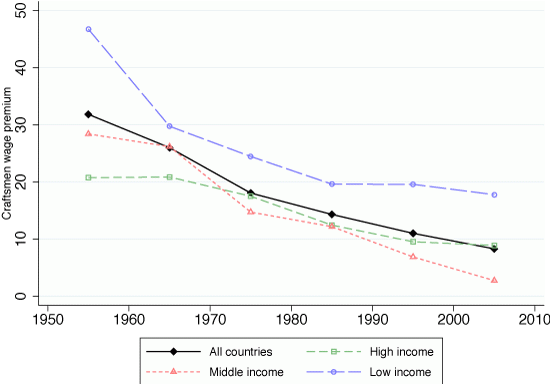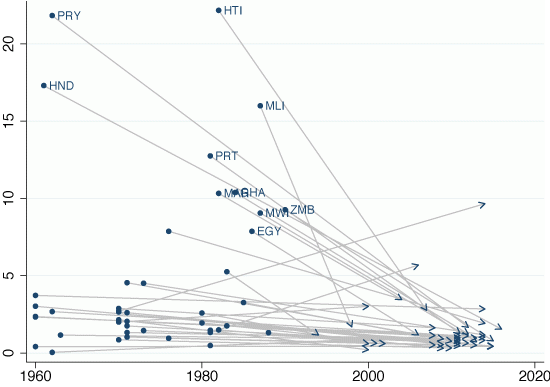Dating back to at least Tinbergen (1974), the literature on skill demand has argued that technological progress is skill-biased in the sense that it requires increasing human capital investment on the part of workers. The recent increase in inequality is then in part viewed as a consequence of increasing returns to skill. In contrast, Braverman (1974) asserts in an influential book from the same year that “the capitalist mode of production systematically destroys all-around skills where they exist”.1
A closer look reveals that both statements may be correct. While the modern literature documents an increasing demand for skilled non-production, or ‘white-collar’, workers in manufacturing (Berman et al. 1994, 1998), Braverman’s claim is about deskilling within the large group of production workers. If he is right, the narrative of technological progress rewarding human capital investments fails to reflect the experience of many production workers: the market value of their skills, often acquired during apprenticeships of several years with low pay, may have declined rather than increased. From this perspective, rising income inequality and polarisation may be the result of declining just as much as of increasing returns to skill, and calling upon workers to make more human capital investments may not be sufficient to allow them to share in the fruits of technological progress.
While the recent literature on labour market polarisation in high-income countries has found more evidence of upskilling than of deskilling (Autor et al. 2006, Goos et al. 2009). Autor (2019) shows that the picture for the US changes dramatically once the focus is on workers without a college degree, which is closer to the group Braverman was concerned about. Over the 1970-2016 period, “almost all occupational change among non-college workers reflects a movement from the middle toward the bottom of the occupational distribution” (Autor 2019).2 In a recent paper, I show that there has been deskilling among manufacturing production workers also on a global scale for more than six decades, drawing on new occupational wage and employment data from more than 150 countries since the 1950s (Kunst 2019a). My findings hence reconcile the conflicting characterisations of technological progress over the 20th century as skill-biased versus deskilling, and suggest that the deskilling of manufacturing production workers’ tasks has contributed to the disappearance of production jobs in which even workers with little formal education could acquire valuable skills.
Global manufacturing through the lens of occupations
To go beyond the coarse white-collar versus production jobs distinction, I draw on harmonised household surveys from the World Bank’s International Income Distribution Data Set, first described by Montenegro and Hirn (2009), and the Integrated Public Use Microdata Series (Minnesota Population Center 2018). In Figure 1, I plot fitted manufacturing employment shares of white-collar workers and two groups of production workers, craftsmen and other production workers, against real GDP per capita.3 It shows that a large majority of manufacturing employees in low-income countries tends to work in craftsman occupations. Their share in manufacturing employment declines with income, but they cease to be the largest group of employees only after an income level of around $10,000 (in 2011 international dollars) and remain important even at higher income levels. In Kunst (2019a), I argue that craftsmen are involved in a larger range of production steps than other production workers, and work in smaller establishments that feature a lower division of labour.4
Figure 1 Fitted occupational employment within manufacturing by GDP per capita
Source: Kunst (2019a).
Notes: The figure shows the predicted manufacturing employment shares from a regression of occupational employment shares among the wage-employed in manufacturing on a third-order polynomial of ln GDP per capita, decade fixed effects and country fixed effects. While the three occupation groups cover almost all manufacturing employees, I do not impose that the fitted employment shares in the three groups in this Figure always add up to 100. See Kunst (2019a) for additional details.
Craftsmen arguably were also the most skilled production workers. For detailed data on relative wages as a proxy for total human capital, I use the extended Occupational Wages around the World database by Freeman and Oostendorp (2019). Figure 2 summarises the wage premia of manufacturing occupations in the 1950s. Handicraft was well remunerated at that time. The typical craftsman earned a wage 16 percentage points above the manufacturing average, whereas the typical other production worker earned a wage 14 percentage points below average. While craftsmen tended to have levels of formal education comparable to other production workers (Kunst 2019a), their substantial wage premium points to higher human capital, acquired for instance through informal apprenticeships and learning on the job rather than formal education.
Figure 2 Occupational wage premia in manufacturing in the 1950s in 112 countries
Source: Kunst (2019a).
Notes: The red diamonds represent the occupation group fixed effects from a regression of log wages on country-year fixed effects and occupation group fixed effects. The dots in light grey are the corresponding coefficients from a regression on the more detailed occupation dummies. See Kunst (2019a) for a full list of these occupations.
The changing fortunes of craftsmen
In the literature, deskilling processes have so far been documented for particular countries and industries. For instance, Rasiah (1993) describes how the adoption of shuttleless air-jet looms in the Malaysian textile industry during the 1980s reduced the demand for some skilled craftsmen. Wallace and Kalleberg (1982) argue that the introduction of teletypesetting technology reduced the demand for skilled compositors in the US over the 1931-1978 period. Figure 3 suggests that these case studies capture parts of a global trend. In a sample with relative wages from the textile industries of 133 countries, the left panel shows that the wages of the craftsman occupation of loom fixers and tuners, relative to the machine-operating cloth weavers on average declined by about 4 percentage points per decade between 1953 and 2008. The right panel shows that the wages of machine compositors relative to printing pressmen in the printing industry declined at a similar rate in a sample of 156 countries.5
Figure 3 Craftsman wage premia: Examples from the textiles and printing industries
Source: Kunst (2019a).
Notes: The wage premium of loom fixers, tuners (a craftsman occupation) over cloth weavers (machine) (a machine operator occupation) in the textiles industry could be calculated for 1,798 country-year observation from 133 countries in the Occupational Wages around the World database, and the wage premium of machine compositors (a craftsman occupation) over printing pressmen (a machine operator occupation) in the printing industry could be calculated for 2,615 country-year observations from 156 countries. The sub-header shows the point estimate and p-value of a regression of the wage premium on a linear trend (year/10) and country fixed effects, with standard errors clustered at the country level.
One may wonder whether the declining craftsman wage premium is specific to the textile and printing industry, or the selected occupations. In Figure 4, I hence plot the evolution of the average craftsman wage premium for a balanced sample of 86 countries, calculated based on all eight craftsman and 13 other production occupations that are available in the Occupational Wages around the World database since 1953. The figure also shows a substantial decline of the average craftsmen wage premium, from about 37 percentage points in the 1950s to about 9 percentage points in the 2000s, and hence of a similar magnitude as for the examples in Figure 3. The dotted lines show that craftsman wage premia declined in countries of all income levels.
Figure 4 Average craftsman wage premium relative to other production workers
Source: Kunst (2019a).
Notes: The average wage premium of manufacturing craftsmen versus other production occupations is based on 86 countries, of which 19 are classified as high income, 43 as middle income, and 24 as low income.
A testable implication of a demand shift away from craftsmen is a simultaneous decline in their relative employment. Figure 5 compares the number of craftsmen per other production worker in the first available year before 1990 with the last available year after 1990 for 44 countries for which I have employment data for both periods. In the first year (on average 1974), there were on average 4.9 craftsmen per other production worker. In the last year (on average 2009), this number had decreased to 1.4 craftsmen per other production worker in the same countries. While a few countries – such as Paraguay (PRY) or Honduras (HND) – experienced particularly large decreases, the number of craftsman per other production worker decreased in 38 of the 44 countries, consistent with a pervasive demand shift away from craftsmen.6
Figure 5 Craftsmen per other production worker in manufacturing
Source: Kunst (2019a).
Notes: The figure assigns country labels to the ten countries experiencing the largest decreases in the number of craftsmen per other production worker.
Discussion
I argue that the declining demand for craftsmen can be understood through the lens of a task model in which a declining price of capital leads to a substitution of craftsman tasks with capital. Consistent with this model, I find that changes in relative craftsman wages and employment within countries over time are significantly associated with changes in manufacturing capital intensities. Task frameworks also highlight that, next to displacing workers, automation may create new tasks (Acemoglu and Restrepo 2019). However, I find that, while craftsman wages decreased relative to occupations outside manufacturing, other production wages did not increase. This suggests that other production workers did not acquire skills comparable to those that craftsmen traditionally possessed, and that any new skill-intensive tasks created by automation have tended to be tasks for white collar workers.
My findings also point to a remarkable continuity in the automation of craftsman tasks in manufacturing, first documented in a literature on deskilling in US manufacturing during the 19th century.7 At the same time, recent case studies from China highlight that deskilling remains a possible outcome of workplace automation even today – in particular in developing countries, where the remaining scope for automation is larger (Huang and Sharif 2017, 2019). Moreover, the accelerating pace of change in labour markets around the world in recent years suggests that the phenomenon of human capital investments losing their market value is increasingly relevant also beyond manufacturing.
These findings do not imply that workers should abstain from making specific human capital investments. Rather, they highlight that, in a technologically dynamic environment, such investments are inherently risky. Hence, social safety nets and subsidised (re-)training programmes have important insurance features which may incentivise workers to undertake such investments in the first place. Strengthening them should be part of the efforts to share the benefits of technological progress widely.
References
Acemoglu, D and P Restrep (2018), “The race between man and machine: Implications of technology for growth, factor shares, and employment”, American Economic Review 108(6): 1488-1542.
Atack, J, F Bateman and R A Margo (2004), “Skill intensity and rising wage dispersion in nineteenth-century American manufacturing”, Journal of Economic History 64(1): 172-192.
Autor, D (2019), “Work of the past, work of the future”, NBER Working Paper No. 25588.
Autor, D H, L F Katz, and M S Kearney (2006), “The polarization of the U.S. labor market”, The American Economic Review Papers and Proceedings 96(2): 189-194.
Berman, E, J Bound and Z Griliches (1994), “Changes in the demand for skilled labor within US manufacturing: Evidence from the annual survey of manufacturers”, Quarterly Journal of Economics 109(2): 367-397.
Berman, E, J Bound S and Machin (1998), “Implications of skill-biased technological change: International evidence”, Quarterly Journal of Economics 113(4): 1245-1279.
Braverman, H (1974), Labor and monopoly capital: The degradation of work in the twentieth century, New York: Monthly Review Press.
Field, A J (1980), “Industrialization and skill intensity: The case of Massachusetts”, Journal of Human Resources 15(2): 149-175.
Freeman, R B and R Oostendorp (2019), “The standardized ILO October Inquiry 1953-2008”, mimeo.
Goldin, C and L F Katz (1998), “The origins of technology-skill complementarity”, Quarterly Journal of Economics 113(3): 693-732.
Goldin, C and K Sokoloff (1982), “Women, children, and industrialization in the early republic: Evidence from the manufacturing censuses”, Journal of Economic History 42(4): 741-774.
Goos, M, A Manning and A Salomons (2009), “Job polarization in Europe”, American Economic Review 99(2): 58-63.
Huang, Y and N Sharif (2017), “From ‘labour dividend' to ‘robot dividend': Technological change and workers' power in South China”, Agrarian South: Journal of Political Economy 6(1): 53-78.
Huang, Y and N Sharif (2019), “Industrial automation in China's ‘workshop of the world'”, The China Journal 81(1): 1-22.
James, J A and J S Skinner (1985), “The resolution of the labor-scarcity paradox”, Journal of Economic History 45(3): 513-540.
Kunst, D (2019a), “Deskilling among manufacturing production workers”, Tinbergen Institute Discussion Paper 19-050/VI.
Kunst, D (2019b), “Premature deindustrialization through the lens of occupations: Which jobs have disappeared, and why?”, Tinbergen Institute Discussion Paper 19-033/V.
Minnesota Population Center (2018), Integrated public use microdata series, international: Version 7.1.
Montenegro, C E and M L Hirn (2009), “A new disaggregated set of labour market indicators using standardized household surveys from around the world”, World Development Report Background Paper.
Rasiah, R (1993) “Competition and governance: Work in Malaysia's textile and garment industries”, Journal of Contemporary Asia 23(1): 3-23.
Rodrik, D (2016) “Premature deindustrialization”, Journal of Economic Growth 21(1): 1-33.
Tinbergen, J (1974), "Substitution of graduate by other labour" Kyklos: International Review for Social Sciences.
Wallace, M and A L Kalleberg (1982), “Industrial transformation and the decline of craft: The decomposition of skill in the printing industry, 1931-1978”, American Sociological Review 47(3): 307-324.
Endnotes
[1] While Braverman (1974) has been cited more than 16,000 times on Google Scholar to date, it has been more influential in sociology than in economics. He also argues explicitly that there has been a “destruction of craftsmanship” throughout the 20th century (p. 94), which points to the deskilling mechanism highlighted in this column.
[2] It is also interesting to note that already Braverman (1974) wrote of a polarisation of labour demand due to automation, 30 years before Goos and Manning (2007) popularised the term to describe the labour market effects of ICT: “Since, with the development of technology and the application to it of the fundamental sciences, the labour processes of society have come to embody a greater amount of scientific knowledge, clearly the "average" scientific, technical, and in that sense "skill" content of these labour processes is much greater now than in the past. But this is nothing but a tautology. The question is precisely whether the scientific and "educated" content of labour tends toward averaging, or, on the contrary, toward polarization” (p. 294).
[3] Craftsmen correspond to major group 7 of the International Standard Classification of Occupations, other production workers include major groups 8 (machine operators) and 9 (elementary occupations). White-collar workers subsume major groups 1-4 (managers, professionals and clerks). The three groups jointly account for almost all manufacturing wage employment, leaving out only some manufacturing employees classified as either sales & service (major group 5) or agricultural workers (major group 6). I exclude self- or family-employed workers from the samples in order to match the occupational wage data.
[4] This is also apparent from the International Standard Classification of Occupations task description. Craftsman tasks “require the knowledge and experience of skilled trades or handicrafts which, among other things, involves an understanding of materials and tools to be used, as well as of all stages of the production process, including the characteristics and the intended use of the final product”.
[5] See Kunst (2019a) for task descriptions of these occupations, which are consistent with the view that the tasks of the craftsman occupation are more complex in both cases.
[6] The choice of 1990 as demarcation year is somewhat arbitrary, but it ensures that there is a reasonable number of countries in the comparison and a reasonable number of years between the first and the last year. However, the decline of the craftsman employment share is a robust feature of the data, see Kunst (2019a) for additional evidence. Only in high-income countries, the employment share of other production workers also decreased alongside craftsman employment. In Kunst (2019b), I argue that this is because these countries have been the first to adopt digitally controlled machines, which substitute for machine operators and elementary occupations. My findings in that paper suggest that even in middle-income countries, increasing technology adoption in recent decades has reduced the number of other production jobs created by automation, resulting in the phenomenon of premature deindustrialisation that has been documented by Rodrik (2016).
[7] See Field (1980), Goldin and Sokoloff (1982), James and Skinner (1985), and Atack et al. (2004). Also see Goldin and Katz (1998) for a model in which the first automation step from artisanal to factory production is deskilling. While they argue that technological change in US manufacturing had become skill-biased already by the early twentieth century, their data do not allow them to distinguish between different groups of production workers. Hence, they mainly rely on the increasing wage bill share of non-production workers as an indicator of skill-biasedness, which does not capture the declining returns to craftsman skills among production workers.








